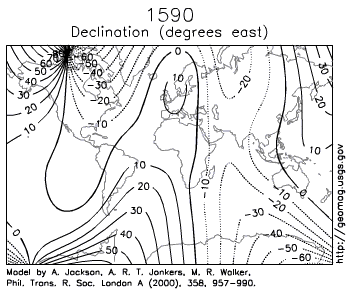This article will describe about Magnetic Declination and Grid Convergent and how to use them for directional drilling purposes.
Magnetic Declination
In the azimuth reference, three North references are Magnetic North, True North and Grid North (Figure 1). Since these 3 North references are not the same direction; therefore, it must be a correction in order to convert any Azimuth in the same reference. Two main concepts, which are magnetic declination and grid convergent, are used to AZI from the magnetic tool to the AZI referencing to the Grid North.

Figure 1 – True North, Magnetic North and Grid North
Magnetic Declination
Magnetic declination is the angle on the horizontal plane between Magnetic North and True North. The angle of Magnetic Declination can be clockwise or counterclockwise from True North to Magnetic North and this will represent either positive or negative declination value as shown in the relationship below.
Angle clockwise from True North to Magnetic North = Positive Declination (East Declination)
Angle counterclockwise from True North to Magnetic North = Negative Declination (West Declination)
Figure 2 simply demonstrates East and West Declination

Figure 2 – Magnetic Declination Simple Illustration
Magnetic Declination varies by the location and time. Declination values can be obtained from either isogonic charts (Figure 3), referred to as “magnetic variation charts,” which are produced by various geophysical and hydrographic institutions around the world, or from computer models, such as those available from the international geomagnetic reference field (IGRF) or the British Geological Survey (BGS). Figure 4 shows the declination changes over time.

Figure 3 – Isogonic charts (https://en.wikipedia.org/wiki/File:World_Magnetic_Declination_2015.pdf)

Figure 4 – Magnetic Declination Varies with Time
Applying Declination
This is a formula to apply the declination.
True Azimuth = Magnetic Azimuth + Declination
Example 1 (Figure 5)
Declination = 15 degree (East Declination)
Magnetic Azimuth = 90 degree
True Azimuth = Magnetic Azimuth + Declination
True Azimuth = 90 + 15 = 105 degree

Figure 5 – Example 1
Example 2 (Figure 6)
Declination = -15 degree (West Declination)
Magnetic Azimuth = 90 degrees
True Azimuth = Magnetic Azimuth + Declination
True Azimuth = 90 + (-15) = 75 degrees

Figure 6 – Example 2
Grid Convergence
Grid convergence is an angle between True North and Grid North. The angle can be clockwise or counter clockwise from True North to Grid North. Positive or negative convergence is described by the relationship below;
Angle clockwise from True North to Grid North = Positive Convergence (East Convergence)
Angle counter clockwise from True North to Grid North = Negative Convergent (West Convergence)
Figure 7 illustrates the grid convergence based on the position of the location in the UTM map.
Applying Grid Convergence
This is the formula to apply the grid convergence.
Grid Azimuth = True Azimuth – Grid Convergence
Example 3 (Figure 8)
True Azimuth = 80 degrees
Grid convergence = 2 degrees (East Convergence)
Grid Azimuth = True Azimuth – Grid Convergence
Grid Azimuth = 80 – 2 = 78 degrees

Figure 8 – Example 3
Example 4 (Figure 9)
True Azimuth = 80 degrees
Grid convergence = -2 degrees (West Convergence)
Grid Azimuth = True Azimuth – Grid Convergence
Grid Azimuth = 80 – (-2) = 82 degrees

Figure 9 – Example 4
Applying Declination and Grid Convergence
Grid Azimuth = Magnetic Azimuth + Declination – Convergence
Example 5 (Figure 10)
Declination = 20 degrees (East)
Convergence = -2 degrees (West)
Magnetic AZI = 90
Grid Azimuth = 90 + 20 +2 = 112 degrees

Figure 10 – Example 5
Summary
True Azimuth = Magnetic Azimuth + Declination
Grid Azimuth = True Azimuth – Convergence
Grid Azimuth = Magnetic Azimuth + Declination – Convergence
References
Adam Bourgoyne, 2014. Directional Drilling and Deviation Control: Definitions and Reasons for Directional Drilling. 1st Edition.
French Oil & Gas Industry Association, 1990. Directional Drilling and Deviation Control. Edition. Technip Editions.
Tom Inglis, 1988. Directional Drilling (Petroleum Engineering and Development Studies) (v. 2). 1987 Edition. Springer.
